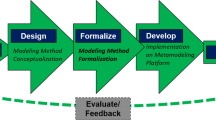Abstract
Traditionally formal papers bridge interpretation gaps of informal OMG specifications. The papers are often not holistic but rather concentrate on certain aspects of the original specification. This increases often the gap between research and practice because it is difficult to understand and combine different semantic methodologies. This paper formalizes and extends the Meta Object Facility of the Object Management Group towards a platform to explore and combine formal methodologies. The extension focuses primarily on algorithms with an action language to define all kinds of normative and desired behavior. The methodology includes mechanisms to support arbitrary dependent language layers. Exemplary syntax and semantics of the methodology is introduced on base of the original specifications. This is complemented by an implementation supporting the graphical definition and simulation of instantiated models. The platform binding is supported by code generators allowing the easy connection of powerful analysis techniques. The platform binding can be done on all layers finding the optimal mixture between independent semantic variants currently in the discussion and established dependent semantic variants strengthening the bridge between research and practice.
Similar content being viewed by others
References
Akehurst DH, Kent S (2002) A relational approach to defining transformations in a metamodel. In: UML’02: proceedings of the 5th international conference on the unified modeling language, pp 243–258
Alanen M, Porres I (2005) Subset and union properties in modeling languages. Technical report, Åbo Akademi University Department of Information Technologies
Damm W, Josko B, Pnueli A, Votintseva A (2005) A discrete-time UML semantics for concurrency and communication in safety-critical applications. Sci Comp Programm 55: 81–115
Eclipse Modeling Framework. http://www.eclipse.org/emf, last visited 21-07-2008
Eclipse Modeling Framework Technology. http://www.eclipse.org/emft, last visited 21-07-2008
Eshuis R, Wieringa R (2001) A formal semantics for UML activity diagrams—formalising workflow models
Graphical Modeling Framework. http://www.eclipse.org/gmf, last visited 21-07-2008
Engels G, Heckel R, Küster JM (2001) Rule-based specification of behavioral consistency based on the UML meta model. Lecture Notes in Computer Science, vol 2185, p 272ff
Object Management Group. MOF—Meta Object Facility Core Specification Version 2.0. http://www.omg.org/cgi-bin/doc?formal/2006-01-01, last visited 08.07.2008
Object Management Group. Unified Modeling Language 2.0 Infrastructure Specification. http://www.omg.org/cgi-bin/doc?ptc/2003-09-15, last visited 04.05.2007
Object Management Group. Unified Modeling Language 2.1.1 Superstructure Specification. http://www.omg.org/cgi-bin/doc?formal/05-07-04, last visited 04.05.2007
Object Management Group. CWM—Common Warehouse Metamodel v1.1, 2003. Last visited 08.07.2008
Object Management Group. SPEM—Software Process Engineering Metamodel v2.0, 2008. Last visited 08.07.2008
Buschermöhle R, Robbe O (2008) Rich meta object facility, complete specification. Technical report, OFFIS
Störrle H (2004) Semantic UML 2.0 Activities. In: International symposium on visual languages/human computer centered systems
Störrle H (2004) Semantics and verification of data flow in UML 2.0 Activities. Visual Languages and Formal Methods
Varró D, Pataricza A (2003) VPM: mathematics of metamodeling is metamodeling mathematics. J Softw Syst Model 1: 1–24
XMI—XML Metadata Interchange Specification v1.2. http://www.omg.org/cgi-bin/doc?formal/2002-01-01, last visited May 2006
Author information
Authors and Affiliations
Corresponding author
Rights and permissions
About this article
Cite this article
Buschermöhle, R., Oelerink, J. Rich meta object facility formal integration platform: syntax, semantics and implementation. Innovations Syst Softw Eng 4, 249–257 (2008). https://doi.org/10.1007/s11334-008-0057-0
Received:
Accepted:
Published:
Issue Date:
DOI: https://doi.org/10.1007/s11334-008-0057-0




